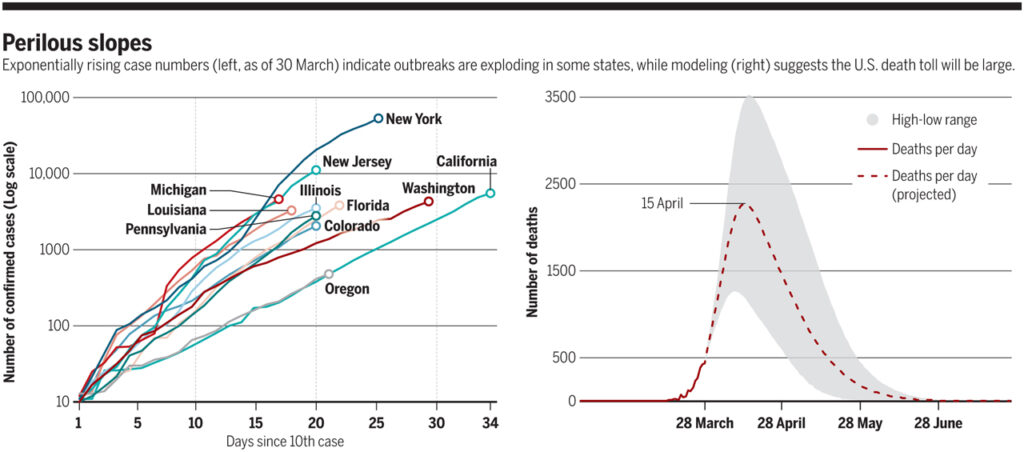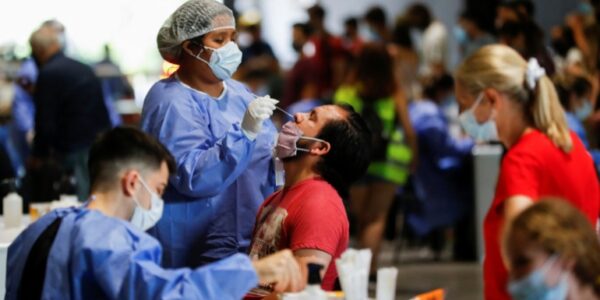The USA strains to act as cases set record
The United States is first, and not in a good way. Last week, it set a grim record, surpassing all other nations within the mentioned quantity of people inflamed with the coronavirus that reasons COVID-19. Officials had documented nearly 200,000 instances as Science went to press on 31 March; the dying toll neared 4000. Even President Donald Trump who just 1 month in the past claimed the virus changed into very an awful lot under management warned that the pandemic is about to get a good deal worse.
To restrict the damage, Trump on 29 March announced that federal
guidelines to practice physical distancing would remain in the vicinity as a minimum via the cease of April, losing his a lot-criticized push for a quicker go back to business as traditional. In the interim, officials throughout the kingdom are scrambling to find sufficient ventilators, shielding equipment, and components for hospitals overwhelmed with COVID-19 sufferers or about to see graphs, underneath proper. Many kingdom governors ratcheted up restrictions to sluggish the pandemic, enforcing stay-at-home orders that some said may want to go into June.

Despite such movements, the U.S. Pandemic reaction remains a work in progress fragmented, chaotic and plagued by using contradictory messaging from political leaders. We do not have a countrywide plan, says epidemiologist Michael Osterholm of the University of Minnesota, Twin Cities. We are going from press conference to press conference and disaster to crisis … trying to understand our reaction. Others are dismayed that the U.S. Centers for Disease Control and Prevention (CDC), which has prominently furnished countrywide management in past outbreaks, hasn’t been more visible. I positive would love to peer loads extra of CDC, says Julie Gerberding, a former director of the business enterprise. The United States is in a reactive mode, says Jeremy Konyndyk, a senior coverage fellow at the Center for Global Development. We’re nevertheless chasing the virus.
To seize up, Osterholm and different researchers have released a flurry of conflict plans within the past week. Many officers have welcomed the recommendations and signaled their guide. But the query now could be whether America a patchwork of extra than 50 nation and territorial governments marked by political polarization and history of fierce resistance to centralized authority can observe through.
The urgency is exquisite. An overview of 12 mathematical models performed by means of federal scientists concluded America is probably to see thousands and thousands of human beings inflamed. The death toll is now possible to attain greater than 100,000 see graph, below proper even with distancing and other measures, Deborah Birx, White House coronavirus reaction coordinator, has said time and again. Some specialists fear even those numbers are too positive, for the reason that outbreaks at the moment are poised to explode in places consisting of Louisiana, Michigan, and Florida which can be ill-organized for the surge of people needing hospitalization.
The new conflict plans usually agree several movements want to be taken right away. Federal, state, and local governments should always urge, if now not order, the majority to live domestic and keep their distance from others. Federal officials need to take a stronger position in directing medical substances to regions maximum in want. Testing for the virus needs to accelerate and expand, in order that people who are inflamed may be quarantined.
But there are numerous boundaries. Testing should soon be hampered by means of a shortage of reagents, caused in part with the aid of the disruption of supply chains in Asia, Osterholm notes. Instead, fitness officers may additionally rely upon much less precise contamination surveillance—documenting the frequency of COVID-19 symptoms to estimate the number of instances.
Persuading more than 320 million Americans to take the pandemic severely, in the meantime, will require a thorough change in messaging from political leaders at every level, from the White House to city halls. Rule one among verbal exchange in a deadly disease is to have a message and persist with it, says political scientist Scott Greer of the University of Michigan, Ann Arbor, who has studied the U.S. Response to the 2014 Ebola epidemic. So far, it truly is been the exception, as Trump and state and nearby officials have added a cacophony of conflicting messages, from indifference to alarm.
Even if lockdowns be triumphant at halting the virus, as they’ve in China, us of needs to marshal huge resources to screen for brand spanking new outbreaks and quickly comprise them, Konyndyk says. Identifying instances and contacts and isolating them will require a huge growth in public medical experts at the local level. Most of what we might need to do to transition far from massive-scale social distancing aren’t in the area, and there don’t seem like plans to position it in place, he says.
The absence of national coordination highlights the department of legal electricity among the federal and kingdom governments, observers say. Governors, now not federal officials, usually keep police powers to shut corporations and enforce curfews. But many are reluctant to invoke those powers and suffer the political expenses without clean direction from above, Greer says. Political department over the pandemic has also hampered decisive action: Polls display Republicans perceive the risk as less critical than Democrats and independents.
To see the results of such divides, Greer factors to Florida, in which Governor Ron DeSantis (R) not on time ordering a statewide closure of seashores, reputedly unwilling to cross the powerful tourism industry and his political base. DeSantis is dependent on a large bloc of citizens who’re Republicans and many are very seasoned Trump. If I’ve got Donald Trump saying basically, Don’t lock down, what political cover do I have? Greer says. Epidemiologists are expecting the delay will get worse in Florida’s outbreak.
New research shows partisan leanings are influencing pandemic response in different states, too. In a preprint released on 28 March, researchers at the University of Washington, Seattle, found that states with a Republican governor or in which Trump fared better in the 2016 election had been much less possibly to have instituted a number of social distancing measures than states led or ruled by Democrats.
Bridging such divisions might be essential if America is to defeat the coronavirus, says Harvard University epidemiologist William Hanage. The closest comparison here, in phrases of countrywide mobilization, is a conflict. And there may be no manner the United States would fight a conflict as 50 separate states.


 For all latest news, follow The carefulu Google News channel.
For all latest news, follow The carefulu Google News channel.





